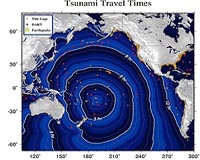| . |  |
. |
Honolulu (AFP) March 10, 2011 Warning sirens went off as Hawaii scrambled to evacuate its coastline late Thursday after a massive earthquake off Japan triggered a tsunami warning extending across much of the Pacific Ocean. The sirens sounded at 9:59 p.m. (0759 GMT Friday) and were to go off every hour on the hour afterwards. The first waves were expected to hit Hawaii around 2:55 am (1255 GMT). "We have about four hours to clear the shorelines," said John Cummings of the Honolulu Department of Emergency Management. "This looks like this will be a very serious event." Hawaii is some 4,000 miles east of the epicenter of Friday's earthquake. Authorities were arranging buses to evacuate residents and trying to open evacuation centers. "All residents in tsunami evacuation zones as shown on evacuation maps ... should evacuate immediately," the emergency department said, referring to prepared maps of areas liable to flood. "A tsunami warning has been issued for the state of Hawaii .. a tsunami warning means a destructive series of tsunami waves has been confirmed by the Pacific Tsunami Warning Center," it added in a statement. The Pacific Tsunami Warning Center, based in Ewa Beach, west of Honolulu, issued a widespread warning extending across virtually the entire Pacific Ocean, including Australia, Antarctica and South America. "A tsunami has been generated that could cause damage along coastlines of all islands in the state of Hawaii," the center said. "Urgent action should be taken to protect lives and property." Waves heights cannot be predicted, and the first wave may not be the largest, it said. People scrambled to stock up on fuel, and arguments broke out as lines formed in front of gas stations, the Star Advertiser reported. Local resident Jake Chang was filling up his truck and a plastic gas container to power his generator. "I was watching TV," he told the newspaper. "I saw the footage of Japan. It was unreal."
earlier related report The destructive wave, triggered by a massive 8.9-magnitude undersea quake just 130 kilometres (80 miles) off the coast, inundated large areas of farmland in northern Japan and set off Pacific-wide warnings. Here is a chronology of some of the major quakes and tsunamis around the world since the Asian tsunami of December 2004 which left more than 220,000 dead in what was one of the world's worst natural disasters: -- December 26, 2004: SOUTHEAST ASIA - A 9.3-magnitude undersea quake off the coast of Sumatra island triggers a tsunami that kills 220,000 people in countries around the Indian Ocean, including 168,000 in Indonesia. -- July 17, 2006: INDONESIA - A 7.7-magnitude undersea quake strikes off Indonesia's Java island, unleashing a tsunami, killing at least 654. -- April 2, 2007: SOLOMON ISLANDS - An 8.0-magnitude quake in the Western Solomon Islands triggers a tsunami that kills 52 people and displaces thousands. -- September 29, 2009: SAMOA - A tsunami sparked by an 8.0-magnitude earthquake flattens villages and resorts in Samoa and the neighbouring Pacific islands of American Samoa and northern Tonga, killing more than 190 people. -- February 27, 2010: CHILE - An 8.8-magnitude earthquake rocks Chile, killing at least 521 people and leaving 56 missing. Most of the dead are in the coastal area of Maule, 400 kilometres (250 miles) south-west of the capital Santiago. -- October 25-26: INDONESIA - At least 112 people are killed and over 500 missing after a tsunami unleashed by a powerful 7.7 magnitude quake strikes off the island of Sumatra. -- March 11: JAPAN - An 8.9 undersea quake triggered a powerful tsunami that smashed into northern Japan. Reports put the size of the wave at as much as 10 metres (33 feet) in the port city of Sendai.
Share This Article With Planet Earth
Related Links Bringing Order To A World Of Disasters When the Earth Quakes A world of storm and tempest
 New System Can Warn of Tsunamis Within Minutes
New System Can Warn of Tsunamis Within MinutesAtlanta GA (SPX) Mar 07, 2011 Seismologists have developed a new system that could be used to warn future populations of an impending tsunami only minutes after the initial earthquake. The system, known as RTerg, could help reduce the death toll by giving local residents valuable time to move to safer ground. The study by researchers at the Georgia Institute of Technology appears in the March 5 edition of Geophysical Researc ... read more |
|
| The content herein, unless otherwise known to be public domain, are Copyright 1995-2010 - SpaceDaily. AFP and UPI Wire Stories are copyright Agence France-Presse and United Press International. ESA Portal Reports are copyright European Space Agency. All NASA sourced material is public domain. Additional copyrights may apply in whole or part to other bona fide parties. Advertising does not imply endorsement,agreement or approval of any opinions, statements or information provided by SpaceDaily on any Web page published or hosted by SpaceDaily. Privacy Statement |